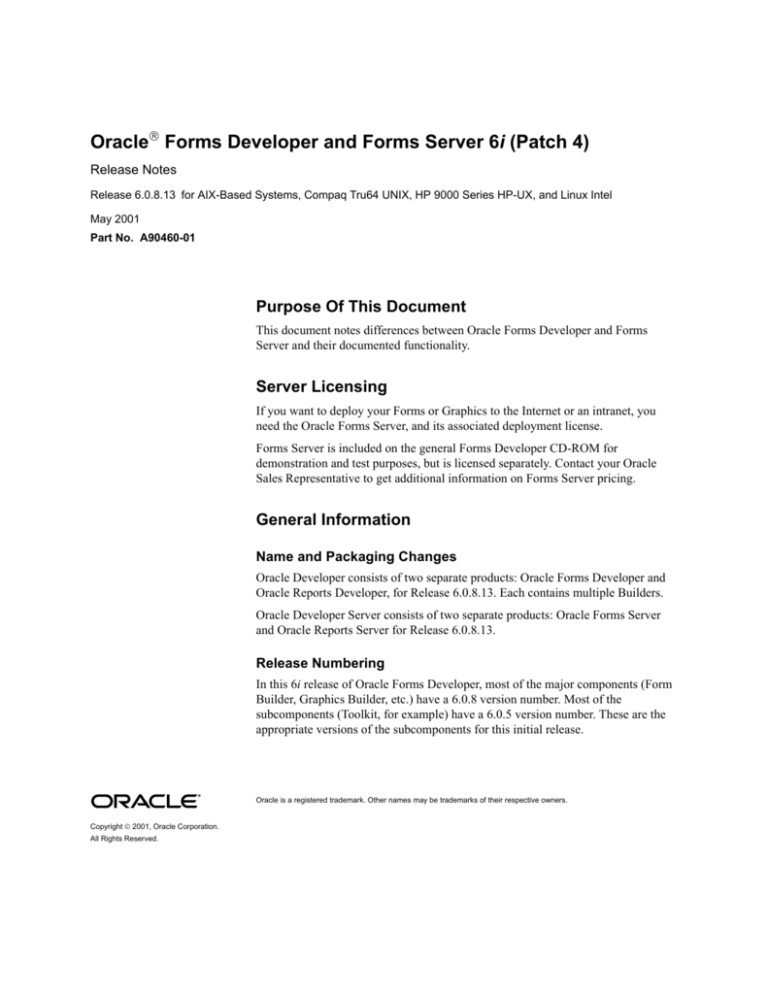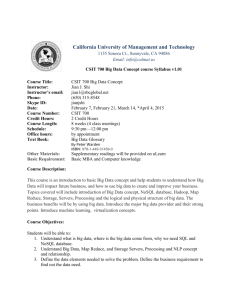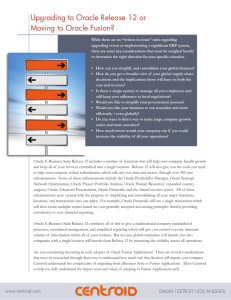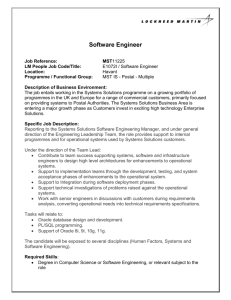
Oracle Forms Developer and Forms Server 6i (Patch 4)
Release Notes
Release 6.0.8.13 for AIX-Based Systems, Compaq Tru64 UNIX, HP 9000 Series HP-UX, and Linux Intel
May 2001
Part No. A90460-01
Purpose Of This Document
This document notes differences between Oracle Forms Developer and Forms
Server and their documented functionality.
Server Licensing
If you want to deploy your Forms or Graphics to the Internet or an intranet, you
need the Oracle Forms Server, and its associated deployment license.
Forms Server is included on the general Forms Developer CD-ROM for
demonstration and test purposes, but is licensed separately. Contact your Oracle
Sales Representative to get additional information on Forms Server pricing.
General Information
Name and Packaging Changes
Oracle Developer consists of two separate products: Oracle Forms Developer and
Oracle Reports Developer, for Release 6.0.8.13. Each contains multiple Builders.
Oracle Developer Server consists of two separate products: Oracle Forms Server
and Oracle Reports Server for Release 6.0.8.13.
Release Numbering
In this 6i release of Oracle Forms Developer, most of the major components (Form
Builder, Graphics Builder, etc.) have a 6.0.8 version number. Most of the
subcomponents (Toolkit, for example) have a 6.0.5 version number. These are the
appropriate versions of the subcomponents for this initial release.
Oracle is a registered trademark. Other names may be trademarks of their respective owners.
Copyright 2001, Oracle Corporation.
All Rights Reserved.
RSF Components Include Additional Bug Fixes
Release 6i includes some RSF components that contain code fixes beyond those in
the formal, numbered patches to the component. These fixes or patch-levels of a
component are sometimes referred to as “one-offs”.
Release 6i includes fixes for the following bugs:
n
1063571
n
1063104
n
1028960
n
1049171
n
1040536
The bug fixes listed above affect the following components:
n
sqlnet
n
rdbms
n
nls
n
plsql
Known Limitations
Co-existence in the same $ORACLE_HOME with Previous Releases
Products
Compatibility
Oracle Developer 1.6.1
and Oracle Forms
Developer 6i
Can co-exist in the same $ORACLE_HOME
Oracle Developer 2.1
and Oracle Forms
Developer 6i
Can co-exist in the same $ORACLE_HOME
Oracle Developer 1.6.1
and Oracle Developer
2.1
Cannot co-exist in the same $ORACLE_HOME
Oracle Developer 6.0
and Oracle Forms
Developer 6i
Cannot co-exist in the same $ORACLE_HOME
Non-Alphanumeric Characters in Database Objects Names
Oracle Forms Developer 6i cannot support tables, or column names that contain
non-alphanumeric ASCII characters.
2
Motif Patch on HP-UX
For Forms/Reports on HP-UX, if the machine has either of the following OS
patches installed:
n
PHSS_21959
n
PHSS_22946
the Forms designer will yield the following error message:
ASSERTION FAILED STATUS = CLIPBOARDSUCCESS FILE UICL.C LINE 985
This problem has been fixed in the latest Motif OS Patchset bundle. To solve this
problem, perform the following steps:
1.
Upgrade the OS to the following Motif Cumulative patchset:
PHSS_23823
2.
Check the patchsets installed on the machine, using the following command:
$ /usr/sbin/swlist -l fileset
Precompilers Compatible With This Release
If you are developing user-exits for Oracle Forms Developer 6i using Oracle
Precompilers, use the versions of the Precompilers that are bundled with the Oracle
8.0.6 release.
ORAINFONAV_DOCPATH Environment Variable on Unix
The ORAINFONAV_DOCPATH environment variable should be set to the location
of the online manuals, on Unix platforms. The default value for this environment
variable is set to the location of the American English version of the online manuals
($ORACLE_HOME/doc60/admin/manuals/US). For Japanese version of the
online manuals, set the ORAINFODOC_DOCPATH environment variable to the
following value:
$ORACLE_HOME/doc60/admin/manuals/JA
Oracle File Packager Not Included
The Oracle File Packager (mentioned in the Forms Developer documentation) is
not included as part of this 6i product.
Sequence of Installing in the Same ORACLE_HOME
To install both Forms Developer 6i and the Database Server 8.0.6 in the same
ORACLE_HOME, perform the following steps:
1.
Install the Database Server.
2.
Install Forms Developer.
3
This sequence will prevent library linking conflicts.
Database Admin Scripts Require OTB
The Database Admin build/drop scripts will fail if they do not find Oracle
Translation Builder SQL scripts.
To avoid this, install Oracle Translation Builder from the product CD.
Additional Step Required for Installation on Unix
In order for the Forms Developer help system to work successfully on a Unix
system, set the ORACLE_AUTOREG variable to the following value:
$ORACLE_HOME/guicommon6/tk60/admin.
The help system requires the autoprefs.oar file, which is the toolkit automation
registry.
TEMPLATES Directory Is Missing
In the document, Oracle Forms Developer and Reports Developer: Guidelines for
Building Applications, references are made to TEMPLATES/.... The TEMPLATES
directory is not included with the product.
Forms Listener Requirement
The Oracle HTTP Listener (powered by Apache) is the recommended listener for
Forms Server.
To use the WebDB listener with the Forms Server, use WebDB 2.2 or higher.
WebDB Listener Can Be Installed Only Once per Machine
Only one copy of WebDB Listener can be installed on a machine. If you try to
install a second copy in another Oracle_Home on that same machine, the first copy
may stop working.
Problem Connecting to Oracle 8.1.6 Server
Customers may not be able to connect to the 8.1.6 database from any of the Oracle
Forms Developer products using operating system authentication. This problem is
due to bug 1139334 in the database server. This issue is resolved in the 8.1.6.1 and
8.1.7 database server releases.
Problem Connecting to Oracle 8.0.6 Server for Forms-Graphics
Forms-Graphics integration does not work correctly when the connection to a local
Oracle 8.0.6 database server is made with only a userid and password (for example,
scott/tiger).
4
To solve this problem, perform the following steps:
1.
Define the local database in the tnsnames.ora file.
2.
Provide a complete connect string when connecting to the database.
For example, scott/tiger@local806.
Custom Install of Wallet Manager Requires Net8 Assistant
Wallet Manager requires Net8 Assistant to launch successfully.
In the typical, default install of Forms Developer, both Wallet Manager, and Net8
Assistant will be installed.
If you choose a custom install, where you select specific components, and you
install Wallet Manager, you need to install Net8 Assistant.
Integration with Oracle Repository
Oracle Forms Developer can be integrated with Oracle Repository.
This 6i release is shipped with a d2sc plug-in (similar to those provided for PVCS,
Clearcase, and other products) that allows integration with Repository for source
control management. Users will be able to check in and check out FMBs, MMBs,
and so forth, and can then use Repository’s dependency tracking and other
advanced functionality.
Use Caution If De-installing Intersolve Drivers
Do not de-install Intersolve drivers (ODBC) from an Oracle home if other products
on another Oracle home on the same machine use these drivers. If you de-install the
drivers from one Oracle home, you will remove them from the entire system.
Form Builder
The following new feature is supported in Forms 6i Patch 4 and is documented in
the white paper Forms 6i Patch 4: Forms Listener Servlet for Deployment of Forms
on the Internet February 2001.
Forms Listener Servlet
Previous releases of Forms use the Forms Listener to manage the initial connection
from a client. The Forms Listener has a shortcoming when used for HTTP or
HTTPS deployment of Forms applications over the Internet. The machine and port
on which the Forms Listener is running are exposed at the firewall. This creates a
potential security risk.
5
Forms 6i Patchset 4 includes the new Forms Listener Servlet. This servlet provides
secure connections when deploying over the Internet because it does not have to
run on a machine that is exposed at the firewall.
Note: Use the Forms Listener Servlet when deploying
applications using HTTP and HTTPS. The Forms Listener is still
available for direct socket connections, and still supports HTTP
and HTTPS connections.
Prerequisites
iAS is required.
What is the Forms Listener Servlet? The Forms Listener Servlet is a Java
servlet that runs on a web server equipped with a servlet engine, such as the
Oracle9i Application Server.
The Forms Listener Servlet manages the following tasks:
n
n
Creation of a Forms Server Runtime process for each client
Network communications between the client and its associated Forms Server
Runtime process
Why Should I Use the Forms Listener Servlet? The Forms Listener
Servlet was designed to allow a more efficient deployment of Forms applications
on the Internet. When compared to the Forms Listener, the Forms Listener Servlet
provides the following benefits:
n
n
n
n
n
Broader range of firewalls and proxies supported. The client browser now
communicates with the web server. As a result, this architecture supports any
firewall or proxy that can work with a standard servlet using servlet sessions.
No protocol restriction (HTTP/1.1 or HTTP/1.0). The use of
HTTP/1.1-compliant proxies provides better performance. As a result, this
architecture works well with HTTP/1.0-compliant proxies, too.
No extra process to manage. Because this architecture eliminates the need for
the Forms Listener process, the administrative tasks to start and stop the Forms
Listener process are also no longer required.
No specific certificate to purchase/manage for SSL deployment. If the
deployment uses SSL (secure sockets layer), the HTTPS connection occurs
between the client browser and web server. Therefore, there are no specific
security configuration requirements at the Forms Server level.
Standard load balancing support. This architecture allows you to use
standard load balancing techniques, such as hardware-based load balancing,
reverse proxy, and standard Apache Jserv load balancing.
6
n
Internet Explorer 5.0 with native JVM support. In addition to working with
Oracle JInitiator, this architecture supports the use of Internet Explorer 5.0 with
native Microsoft JVM for Internet deployment using HTTP and HTTPS
connection modes.
See Also:
For more information on Forms Listener Servlet,
refer to the white paper Forms 6i Patch 4: Forms Listener Servlet
for Deployment of Forms on the Internet.
For updates on this white-paper, refer to the following web-site:
http://docs.oracle.com
Effect of Fill Patterns on Performance
If you assign a fill pattern to a large Forms object, you may degrade runtime
performance on the web. Objects are filled in 64x64 pixel increments. Objects
larger than 64x64 require multiple operations.
For example, painting a window of size 800x600 would require 120 such
operations.
To avoid this problem, perform the following:
n
n
Avoid using fill patterns for large objects unless doing so is a significant user
requirement.
Minimize the number of different patterns. Each pattern used requires 4K of
memory.
Undocumented Error Messages (FRM-99999)
Any Forms error message not documented in the online help will display the
following generic message:
FRM-99999 Error FRM-nnnnn occurred, please consult the release notes.
The details of these error messages are documented in the following table:
Error Messages 1412 and 1413
FRM-99999,
Error 1412.
An attempt was made to set scrollbar position on a block that
has no scrollbar.
FRM-99999,
Error 1413.
An attempt was made to get scrollbar position on a block that
has no scrollbar.
Error Messages 10905-10909
Error Message
Cause
7
Action
FRM-10905:
The following
return values are
invalid
The invalid return values must Enter a valid return value.
be corrected before you can
Return values must be one of
leave this page of the wizard. the following:
n
n
n
A fully qualified Item
name (<BLOCK_
NAME>.<ITEM_
NAME>).
A Form Parameter
(PARAMETER.<PARA
METER_NAME>).
A global PL/SQL
variable
(GLOBAL.<VARIABLE
_NAME>).
FRM-10906:
One or more
LOV columns
has a negative
width
One or more of the columns in Ensure that no columns in the
the table has a negative width. table have a negative width
FRM-10907:
The LOV size or
position has a
negative value
One or more of the attributes
Ensure that none of the LOV
of the LOV size and position is size or position attributes is
negative
negative
FRM-10908:
Number of rows
retrieved is less
than or equal to
zero.
The number of rows retrieved
is less than or equal to zero.
Enter a value greater than
zero for the number of
records retrieved.
FRM-10909: Old The LOV Wizard was invoked Create a new LOV based on a
on an Old-Style LOV
Record Group.
Style LOVs
cannot be
modified using
the LOV wizard.
Error Messages 13009-13010
Error Message
Cause
Action
FRM-13009:
The JavaBean
does not
implement the
IView interface.
For Forms to use this
JavaBean, it must implement
Oracle Forms IView interface.
Implement Oracle Forms
oracle.forms.ui.IView
Interface.
8
FRM-18010: An
unknown error
occurred when
attempting to
process the
JavaBean.
For Forms to use this
JavaBean, it must be able to
locate the specified JavaBean
and instantiate it.
Ensure that the specified
JavaBean and supporting
classes are installed correctly.
Retry the JavaBean after
restarting Form Builder.
Error Messages 18114-18121
Error Message
Cause
Action
For Web Preview from the
FRM-18114:
Builder to work the Registry
FORMS60_
JAVADIR not set variable FORMS60_JAVADIR
must point to the location that
contains the Forms Java files.
This variable should have been
set by the Oracle Installer
when Oracle Forms Developer
was installed. A typical value
for this variable is
c:\orant\forms60\java.
Create or update the registry
variable on NT, FORMS60_
JAVADIR, and set its value to
the location that contains the
Forms Java files.
FRM-18115:
CLASSPATH
variable not set.
For forms to run on the Web
the environment variable
CLASSPATH must point to the
location that contains a valid
Java installation. This variable
should have been set by the
Oracle Installer when Oracle
Forms Developer was
installed.
Create or update the
environment variable
CLASSPATH and set its
value to the location that
contains a valid Java
installation.
FRM-18116: The
CLASSPATH
does not contain
a reference to
Forms.
For Forms Server to work, the
environment variable
CLASSPATH must include an
entry that points to a location
containing the Java files
required by Oracle Forms. An
entry should have been added
to the existing CLASSPATH
variable by the Oracle Installer
when Oracle Forms Developer
was installed. A typical value
for this variable is
c:\orant\forms60\java.
Create or update the
environment variable
CLASSPATH and set its
value to the location that
contains the Java files
required by Oracle Forms.
9
FRM-18117: The
preferences
contains a
reference to a
non-existent
HTML file
In the Runtime Preferences dialog
an HTML file has been specified,
but that HTML file does not exist,
or the location specified does not
exist.
In the Runtime Preferences
dialog either remove the
reference to the offending
HTML file, so that the default
HTML file is used, or specify an
HTML file that exists.
Alternatively place the HTML
file in the location specified.
FRM-18119:
ORACLE_JDK
variable not set
For Forms Server to work, the
environment variable
ORACLE_JDK must point to
the location that contains a
valid Java installation. This
variable should have been set
by the Oracle Installer when
Oracle Forms was installed.
Create or update the
environment variable
ORACLE_JDK and set its
value to the location that
contains a valid Java
installation.
FRM-18121:
The JavaBean
does not
implement the
IView interface.
For Forms to use this
JavaBean, it must implement
Oracle Forms IView interface
Implement Oracle Forms
oracle.forms.ui.IView
Interface.
Forms Environment Variable Added
The following is a new environment variable available with Release 6.0.8.13:
FORMS60_WEB_CONFIG_FILE
Use this variable to specify the full path and name of the Forms CGI configuration
file.
For example: FORMS60_WEB_CONFIG_FILE=c:\temp\myfile.cfg
The default value is <ORACLE_HOME>\forms60\server\formsweb.cfg
Java Keybindings API Provided
To provide consistent, configurable, and efficient keybindings in Forms, a
keybinding API is provided. This API first downloads keybindings to the client.
The API can then query the key sequence and return the corresponding form action
or query the form action and return the corresponding key sequence.
FormAction.java
Standard form actions are defined in FormAction.java. These form actions are
static instances of the class FormAction. For example, the Next Field form action
can be addressed as FormAction.FA_NEXT_FIELD.
10
The constants for the various form actions in FormAction.java are obtained from
frmweb.res. The beginning of the keybinding constants in FormAction.java, are
described below:
public class FormAction extends Property
{
/*
** The constants (or id’s) for various forms actions have
** been obtained from frmweb.res. These id’s will not change.
** New forms actions will be assigned new id’s.
*/
public static final FormAction FA_NEXT_FIELD
= new
FormAction(1);
public static final FormAction FA_PREVIOUS_FIELD = new
FormAction(2);
public static final FormAction FA_CLEAR_FIELD
= new
FormAction(3);
.
.
.
A list of all the static constants for keybindings included in the FormAction.java
class is shown below:
FA_NEXT_FIELD
FA_PREVIOUS_FIELD
FA_CLEAR_FIELD
FA_UP
FA_DOWN
FA_SCROLL_UP
FA_SCROLL_DOWN
FA_EDIT
FA_RETURN
FA_LIST_OF_VALUES
FA_HELP
FA_EXIT
FA_SHOW_KEYS
FA_COMMIT
FA_NEXT_PRIMARY_KEY
FA_CLEAR_RECORD
FA_DELETE_RECORD
FA_DUPLICATE_RECORD
FA_INSERT_RECORD
FA_NEXT_SET_OF_RECORDS
FA_NEXT_RECORD
FA_PREVIOUS_RECORD
FA_CLEAR_BLOCK
FA_BLOCK_MENU
FA_NEXT_BLOCK
11
FA_PREVIOUS_BLOCK
FA_DUPLICATE_FIELD
FA_CLEAR_FORM
FA_ENTER_QUERY
FA_EXECUTE_QUERY
FA_DISPLAY_ERROR
FA_PRINT
FA_COUNT_QUERY
FA_UPDATE_RECORD
FA_FUNCTION_0
FA_FUNCTION_1
FA_FUNCTION_2
FA_FUNCTION_3
FA_FUNCTION_4
FA_FUNCTION_5
FA_FUNCTION_6
FA_FUNCTION_7
FA_FUNCTION_8
FA_FUNCTION_9
FA_LIST_TAB_PAGES
KeyBinder.java - Using the API
To use the KeyBinder API to download keybindings and get a requested form
action or key sequence, perform the following steps:
1.
In your start-up code, execute the following command:
downloadKeyBindings()
2.
To test if the keybindings are available on the client, execute the following
command:
isKeyBindingsAvailable()
3.
If the keybindings are available, to get the key sequence for the requested form
action, execute the following command:
getKeySequence
or
To get the form action for the requested key sequence, use the following
KeyEvent event command:
getFormAction
4.
Execute the following KeyBinder.java API methods:
a.
To request the server to send the bindings, if the keybindings have not
been created on the client, use the following command:
public synchronized static void downloadKeyBindings()
12
This is not a blocking call, because we do not want to incur a round-trip
for getting keybindings from the server. The next time a round- trip
occurs, the server will send the necessary information.
b.
To return a cloned table of all the keybindings, perform the following
command:
public synchronized static Hashtable getKeyBindings()
c.
To check if the keybindings are available on the client, perform the
following command:
public synchronized static boolean isKeyBindingsAvailable()
d.
To get the key sequence corresponding to a requested form action, perform
the following command:
public synchronized static KeyEvent getKeySequence(FormAction
action)
e.
To get the form action corresponding to a requested key sequence, perform
the following command:
public synchronized static FormAction getFormAction(KeyEvent
event)
Example of KeyBinder.java API
The following example shows programming pertinent to the use of the
KeyBinder.java API to get the form action from the keys pressed.
KeyBinder.downloadKeyBindings();
// get bindings from server
Then in a text field’s processKeyEvent(KeyEvent e) implementation, this handles
events:
// If we have key bindings, see whether this event maps to
// one that we care about.
// If it does, record which event it is with the name of
// the action that goes with it.
// Many actions can be invoked by buttons, key presses,
// and/or menu selections...
if (KeyBinder.isKeyBindingsAvailable())
{
String
actionName;
FormAction fact = KeyBinder.getFormAction(e);
if (fact == (FormAction) null)
{
// if no binding found, issue message.
system.out.printer("No binding found.");
13
}
else if (fact == FormAction.FA_LIST_OF_VALUES)
actionName = "LOV";
else if (fact == FormAction.FA_EDIT)
actionName = "FLDEDIT";
else if (fact == FormAction.FA_EXIT)
actionName = "CANCEL";
else
{
}
.
.
.
Requirements for Using Run_Product on the Web
If you use Run_Product in a form to run a report and want to display the output in
the browser window, remove the TMPDIR environment variable.
Using Index-Only Tables
To use an index-only table in Forms, the block’s Key Mode should be set to either
Updateable or Non-Updateable. A Primary Key should also be nominated.
Netscape Users Prompted to Save Report HTML File
The installation process for Forms Server creates a registry entry named
FORMS60_REPFORMAT with value of “HTML” (upper case).
If a user is running a Forms applet in a Netscape browser that launches a report,
instead of opening the report in a browser window, the user will be prompted to
save the report HTML file.
To avoid this, set the FORMS60_REPFORMAT registry entry to “html” (lower
case).
Forms-Reports Integration Requires that TMPDIR Not Be Set
Forms-Reports integration works on the web on a Unix system, if the variable
TMPDIR is not set. Unset this environment variable before starting the Forms
listener.
Changing Font Causes Problem in Forms
When using Form Builder, if you draw a text object and subsequently change its
font, the copy, paste, and delete keys will stop working.
Using Oracle Trace Collection
Oracle Trace Collection is a beta feature in Forms Server Release 6i.
14
CAB Support in IE and Java Security
The Forms 6i CAB file (f60all.cab) supports default Java security settings (high,
medium, and low) in the browser. Since it provides the most secure environment
for Java code execution, the high security setting is recommended. If using Custom
security settings, set the Unsigned content flag to either enabled or run in sandbox.
Java Importer
The Java Importer does not function when the web preview mode of the builder is
used. It functions in client/server runtime mode and in a deployment environment
with Oracle Forms Server. The Java Importer requires a separate, manual
installation of JDK 1.2.2 before use.
OEM and Forms Internal Job
In the Oracle Enterprise Manager (OEM) console, when creating a job under the
Developer server node, there may be items listed in the Tasks tab that are labeled
"Forms Internal Job." These are Forms internal tasks and must not be scheduled in
an OEM job.
Load Balancing Server Trace Log
A load balancing server trace log file is created when the load balancing
server--d2ls60--is started with a trace level greater than 0. The default name for the
log file is d2lslog.txt. When the d2ls60 load balancing server is started from the
command line, the default location for the d2lslog.txt log file is the directory from
which the load balancing server was started.
LIBPATH, SHLIB_PATH, LD_LIBRARY_PATH
Append the following to the end of the corresponding environment variable before
installing Forms and Reports 6i:
Platform
Environment
Variable
AIX
LIB_PATH
$ORACLE_HOME
/6iserver/network/jre11/lib/aix
/native_threads
HP
SHLIB_PATH
$ORACLE_HOME
/6iserver/network/jre11/lib
/PA_RISC/native_threads
Linux Intel
LD_LIBRARY_
PATH
$ORACLE_HOME
/6iserver/network/jre11/lib/linux/native
_threads
15
Append Text
Tru64
LD_LIBRARY_
PATH
$ORACLE_HOME
/6iserver/network/jre11/lib/alpha
/native_threads
If this value is not set, Reports linking may fail during installation.
Open Bugs
Fixes for the following bugs were scheduled for but not included in this patch
release. Check the bug database for more information.
Bug Number
Description
1643859
Chart Item labels are not displayed correctly
1647725
Dev6i-P4: Web Status Bar has a couple of “..”s and focussing on
it shows empty tool tip
1647552
Dev6i-P4: Web iAS cannot write image back to the file system
1645907
WebForms Servlet: iAS Shiphome not able to connect to
database after disconnection
National Language Support
Known Problems for All Languages
Form Builder User Interface May Not Be Fully Translated
Customers who install the Forms Builder with a language other than English may
find that the user interface contains both the local language and English. The Forms
Builder does not have complete translation for some languages.
For these languages, use the English language interface, by performing the
following steps:
1.
Set DEVELOPER_NLS_LANG=AMERICAN_AMERICA.<charset> USER_
NLS_LANG=< Language>_<Territory>.<charset> on the workstation that is
running the Builder.
2.
Substitute < Language> with the Language you want to run your form in.
3.
Substitute < Territory> with the Territory you want to run your form in.
4.
Substitute for <charset> the Oracle character set that you wish to use.
Wizard Buttons Have Untranslated Text
In the wizards on Unix systems, some buttons appear with their texts in English.
16
Menu Action Not Available Via Keyboard After Print Cancel
When accessing a form via keyboard commands, and selecting a print dialog and
then cancelling that dialog several times, the print dialog could not be brought up
again.
Avoid repeated cancelling.
FMRWEB.RES Must Be Configured Manually
The file "fmrweb.res" contains a keyboard map. This map is used by Oracle Forms
Server to detect key strokes entered in the user’s browser and map them to Forms
actions. The map assumes that the keyboard is similar to a VT100 keyboard. If the
user has a PC-style keyboard, copy the file "fmrpcweb.res" over the original
"fmrweb.res". This will make the server assume that the keyboard is similar to a
101-key "PC" keyboard.
The US versions of fmrweb.res and fmrpcweb.res are installed, by default,
regardless of language. For a particular language, the appropriate mapping files for
that language’s typical keyboard are also installed. The mapping files are installed
to the files "fmrweb<lang>.res" and "fmrpcweb<lang>.res", where <lang> is the
Oracle language code. For instance, the Oracle language code for Latin American
Spanish is “esa”. To use the files for a particular language instead of the US
versions, copy the desired file over the file "fmrweb.res".
Starting with Oracle Forms Server 6i, the files “fmrweb<lang>_utf8.res” and
“fmrpcweb<lang>_utf8.res” are also installed. These contain the same key
mappings as “fmrweb<lang>.res” and “fmrpcweb<lang>.res”, but the files are
encoded in the UTF8 character set. These files should be used if the server is using
the UTF8 character set. UTF8 is the character set specified in NLS_LANG.
Information About NLS_LANG Parameter Values The manual Deploying
Forms Applications to the Web refers to a file named \bonus\nls\nlsdrl.wri. This file
is obsolete, and is not supplied on the product CD.
For information about parameter values for NLS_LANG, consult the
documentation for the Oracle8 8.0.6 server. The valid NLS_LANG parameter
values are the same for Forms and for that database server.
Wallet Manager User Interface Is in English When you install Wallet
Manager from the Forms Developer CD, the user interface is in English only.
Oracle Wallet Manager translations can be obtained if required. Contact your
Oracle representative for more details.
Known Problems for Double-Byte Languages
Editing with Single-Byte Font
17
In any double-byte language implementation of the Builders, editing using a
single-byte font face (such as Arial) causes characters to become distorted or
unreadable. This occurs in any editing field.
Use double-byte fonts that display Roman script, instead of using the single-byte
font.
Message Texts from PL/SQL Interpreter are in both Languages
When running Procedure Builder, error messages (for example, ORA-04098) from
the PL/SQL Interpreter are sometimes displayed in English and sometimes in
Japanese.
Storage Requirement for Installing Cue Cards on Unix
If you choose to install the Cue Cards on a Unix system, both the Japanese tar files
and the US tar files will be installed.
The total storage requirement for these tar files is approximately 275Mb. The Cue
Cards are optional. If your storage space is limited, you may choose to not install
the Cue Cards.
18







